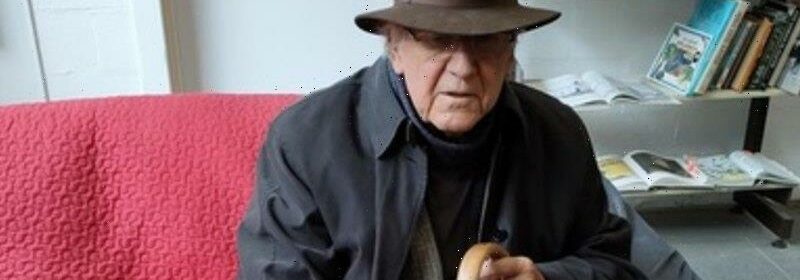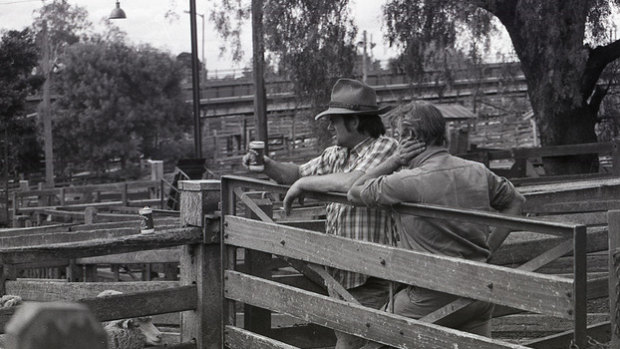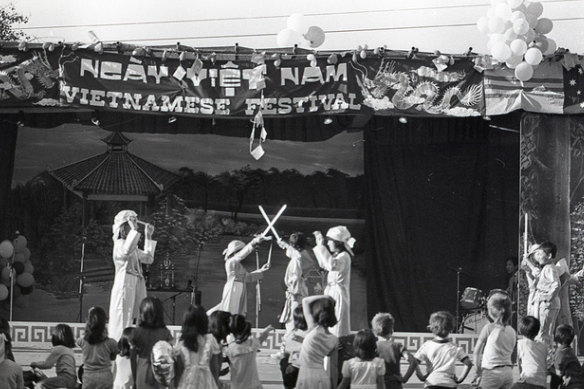An advocate for the histories of the west

PETER HAFFENDEN March 30, 1946-October 14, 2022
When Peter Haffenden could no longer visit the museum that became his life’s work, the museum’s collection came to him.
In the hours after his death aged 76, with the floodwaters of the Maribyrnong threatening to breach the museum’s walls, staff transported hundreds of historically significant items to the former museum director’s home in Footscray.
It was a fitting end for a man who had dedicated much of his life to saving the stories of Melbourne’s western suburbs.
Haffenden joined the Living Museum of the West at its inception in 1984 and helped trail-blaze the oral history movement in Australia. He worked at Melbourne’s western suburbs museum for nearly four decades. Under his stewardship and influence, the museum recorded the stories of local women, workers, First Nations peoples and migrants. He advocated for histories of the west’s land and industry.
He encouraged new local historians and students to find their voice at a time when researching any kind of local or family history meant hours at the Public Record Office or writing to the Births, Deaths and Marriages office. Driven by demand, this information is now largely online.
In 1984, Haffenden had been exploring various pursuits and ideas while on the dole for 10 years, and faced with having his income cut off, he attended a job interview for a new museum.
Driven by the former Victorian premier and Williamstown MP Joan Kirner, the state government was funding a new museum to focus on Melbourne’s west which would later be based at Pipemakers Park in Maribyrnong. Haffenden was hired as one of 20 unemployed people to develop the museum. It needed storytellers who could photograph and interview people from the west. Its first exhibition would coincide with the 150th anniversary of Victoria.
Olwen Ford was on the interview panel that hired Haffenden as the media co-ordinator as he had worked for both The Age and the ABC. He also had a photography diploma and had grown up in Maidstone and Footscray.
“He was full of energy and keen to talk,” Ford said. To her recollection, Haffenden said at the time: “I’ve been looking for something like this all my life.”
Haffenden dedicated the rest of his life to the museum.
When he was a child, Haffenden’s parents owned a milk bar in Barkly Street, West Footscray. Wanting a good education for her children, his mother bought an encyclopedia set and Haffenden devoured them. From grade six, aged 10, he left North Footscray Primary School for Essendon Grammar where the school placed him in form two. Without telling his parents, the following year he enrolled himself instead at Maribyrnong High School. It was a homecoming. He loved to hear the stories of migrants and workers from his friends. At school, he became friends with Age cartoonist Michael Leunig. Years later, Leunig’s father Bernard, a meatworker, would appear in a museum book titled, The Life Blood of Footscray.
In the old Newmarket sale yard in Melbourne’s inner west.Credit:Peter Haffenden
In his teens, Haffenden was a bit of a brawler with local kids but would also organise dances and youth events through St Andrew’s Church in Footscray. The seeds of a curator – as an organiser of events and theatre – were sewn. His life partner, artist Kerrie Poliness said growing up in Footscray had made him passionate about local stories.
“Footscray, it’s incredibly multicultural, and at Maribyrnong High, there were kids from all different backgrounds,” Poliness said.
“He found that kind of white-Anglo privilege made him nervous and was, ultimately, very boring.”
At Melbourne University Haffenden studied commerce and immersed himself in university theatre life. After three years at uni, in the late 1960s, Haffenden joined a “goodwill” tour of Japan. Leaving on a ship from Darwin, he and about 200 other students slept in hammocks and ate nasi goreng. During the journey, he was lucky to survive when a storm nearly blew him and a friend overboard. He latched onto a rail at the last moment and clung on. The trip opened his eyes and mind.
After university, he joined the corporate ladder at Shell oil company and loathed it. He tried his hand at small businesses, factory work, taxi driving and as a court reporter for The Age. He joined the ABC as a mature-age reporter in late 1972 where he met reporter Stephen Rice. They clicked. Both realised that wearing a suit and working for the ABC was like a “passport” to everywhere, everyone and almost every opportunity.
“Peter was artistically inclined, and he worked out that life was like a theatre,” Rice said. “The suit was the costume you put on and that gets you access to places you can never otherwise go – that and the ABC.”
Rice said his friend also learned how to communicate and cajole powerbrokers while wearing a suit, which stood him in good stead when lobbying for museum funding. Respectfully, he refused to speak to underlings when he needed decision-makers.
Haffenden led a Bohemian life, mostly in Carlton in the 1970s and early 1980s. Ten o’clock closing in hotels meant Haffenden and Rice kept the party going at their homes. They took their first LSD trips together. They became devoted vegetarians but by the mid-1970s Haffenden had left the ABC and was studying art and later photography.
Haffenden lived with Wendy Lea and her two children and became a father figure to them. During this period, he tried his hand at taxi driving and selling mud crabs to restaurants to support his much-loved adopted family.
“It was an amazing thing that he did. He was a very generous, warm-hearted person,” Rice said.
International model Janni Goss employed both Wendy and Peter at Cafe Paradiso, her electric Lygon Street cafe. Rice said there the couple met many young talented creative types and made the cafe “their own”.
The Living Museum of the West’s first exhibition in 1985 was called Chops and Chimneys and was staged at the Melbourne Showgrounds’ pavilion. Haffenden, along with fellow photographer Joe Mastroianni took most of the images. Olwen Ford said Haffenden had the skills for the job and an interest in the exhibition’s topic.
“He was brilliant at designing and creating exhibitions,” Ford said.
She said the exhibition focused on the people of Melbourne’s west and Haffenden championed putting them “at the front, as the storytellers using their own words”.
“Peter had a great rule about text, a limit of 100 words to summarise the theme you’re talking about. So that was a good discipline,” Ford said.
When Ford retired in 1997, Haffenden took over as museum director.
Haffenden was passionate about Indigenous stories and worked closely with Robert Mate Mate (Gapingaru), an initiated elder of the Woorabinda-Birri Gubba in Central Queensland, who became the museum’s cultural officer. Later, Taungurrung man Uncle Larry Walsh was hired as the Aboriginal liaison officer, and other First Nations expertise was found in Wendy Berwick and Edgar Harris. Haffenden strongly supported the museum-linked Koori Gardening Team.
Haffenden worked closely with the Vietnamese community, especially the Quang Minh Buddhist Temple in Braybrook where he helped develop an “industrial grade worm farm” to deal with food scraps from the 500 meals the temple produced every week.
At the Vietnamese Festival at Footscray Park.Credit:Peter Haffenden
Poliness said Haffenden only admitted to crying three times in his life.
“He cried when he found out that the Wurundjeri still existed; when our daughter was born; and when Footscray won the grand final [in 2016],” Poliness said. “Not because he liked football, but because he knew so many people, like our next-door neighbour and the people he grew up with, who had followed the Bulldogs for so long. He knew what it would mean to them.”
Ford said from the outset Haffenden was instrumental in developing a “museum by product” to attract government funding.
“We were very much obliged to come up with products all the time,” Ford said. “Whether it was postcards or cards or exhibitions or books or concerts.”
Often the research was repurposed to produce a second or third “product” to attract further funding.
After he retired in 2007, he and Poliness worked on Volcanic Dreaming a project on the critically endangered Victorian volcanic plains biosphere. It was placed on permanent display at the Department of Environment, Land, Water and Planning headquarters in East Melbourne in 2009.
He returned to the museum’s management committee and became an active volunteer. Poliness became the museum’s president in 2019.
Western suburbs historian Maureen Lane said Haffenden was supportive of her first self-published book Pubs, Punts and Pastures (with Joan Carstairs) in 1988. The book featured Lane’s women ancestors who owned hotels and operated farms and river punts from Footscray to Keilor.
“He came to our book launch and really spread the word,” Lane said.
The book was sold through the museum and the money raised built a riverside rotunda between the museum and the riverfront celebrating the contribution of pioneering. It was designed by Poliness with the museum. Haffenden arranged for government maintenance of the shelter.
Away from the museum, Haffenden enjoyed camping on a Point Lonsdale block his parents had bought which led him to found the Friends of Buckley Park in 1999, a group dedicated to the preservation of the coastal dunes between Point Lonsdale and Ocean Grove.
Dying at home allowed friends and family to visit and say goodbye to Haffenden, both before and after his death, Poliness said. The Venerable Thich Phuoc Tan OAM provided a blessing to guide his spirit, she said.
On the day Haffenden died, Poliness contacted the museum to say it should close for the day and the staff should come around for a whisky to celebrate his life. It was then that she learned the Maribyrnong River was heading for the museum and was expected to rise further.
“We got all the audiotapes, the transcriptions and negatives, the photographs, the computer hard drives, the database – those things that are completely irreplaceable – and they got them all in their cars and brought them here,” Poliness said.
Among the items were 20,000 negatives that Haffenden had scanned during the state’s COVID lockdowns.
Donations to the Peter Haffenden Future Project Fund can be made via the museum’s website. He is survived by his partner Kerrie Poliness and their daughter Phoebe.
Deborah Gough is a former Footscray Mail and Age reporter. She is the president of the Life Stories Australia association and is an author and publisher.
Most Viewed in National
From our partners
Source: Read Full Article

